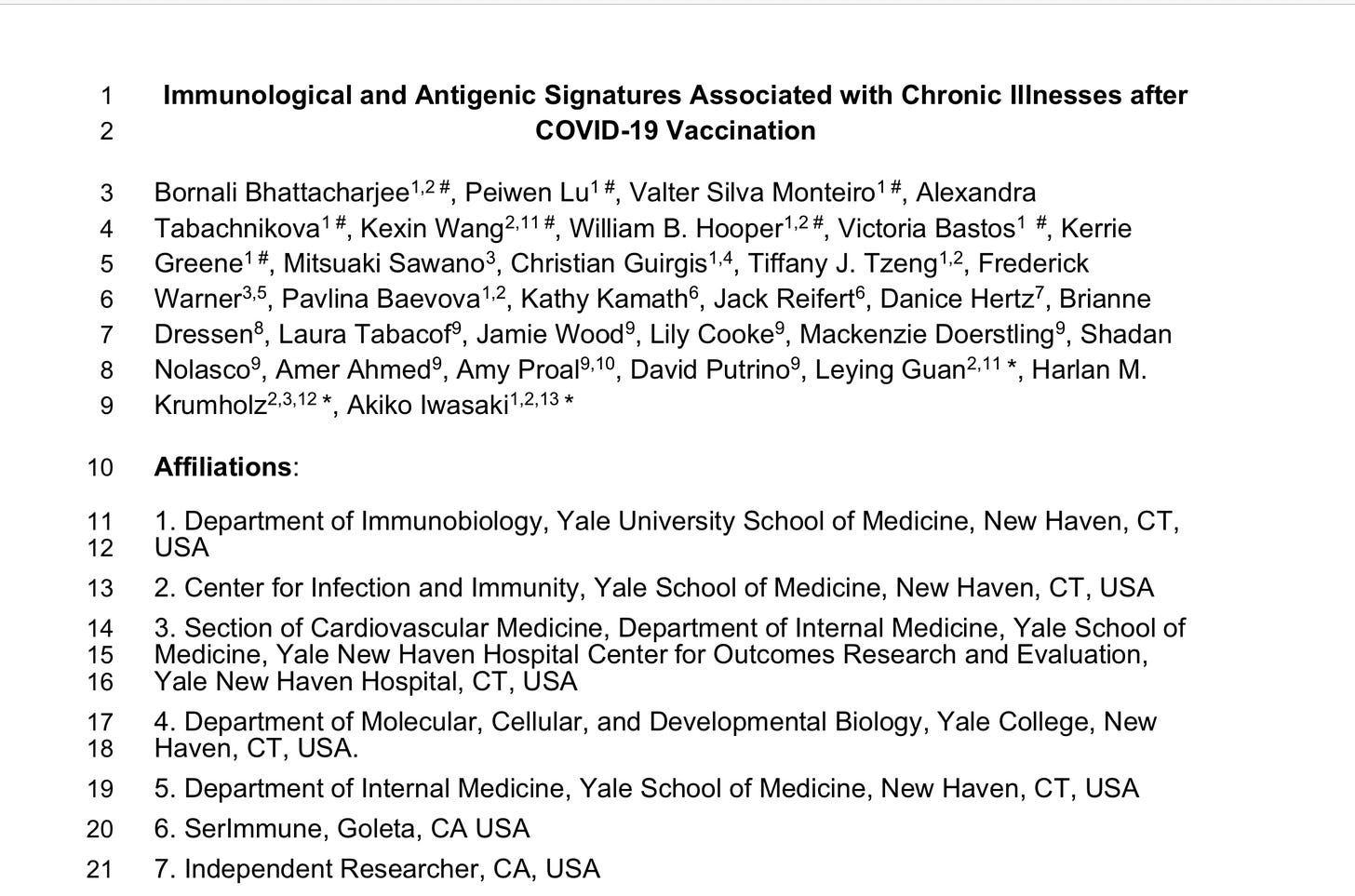From Fringe to Frontline: Yale Study on Post-Vaccination Syndrome Challenges the Narrative
Once Dismissed as Conspiracy, Persistent Spike Protein and Immune Shifts Post-COVID Vaccination Gain Scientific Traction
Not long ago, suggesting that COVID-19 vaccines could lead to prolonged immune issues or lingering spike protein in the body was a ticket to the conspiracy theory blacklist. Social media platforms throttled such claims, labeling them misinformation, while fact-checkers raced to reassure the public that mRNA vaccines were transient—here today, gone tomorrow, leaving only immunity in their wake. The idea of T-cell exhaustion, spike protein hanging around for years, or—gasp—mRNA integrating into human DNA was relegated to the realm of tinfoil hats and shadow-banned X posts. But a new preprint from Yale researchers, posted on medRxiv on February 18, 2025, is forcing a hard pivot. Titled "Immunological Features of Post-Vaccination Syndrome after COVID-19 Vaccination," this study doesn’t just flirt with these once-taboo ideas—it backs them with data, pulling them from the fringes into the spotlight.
The Study: A Crack in the Consensus
Led by scientists including Yale-affiliated researchers, the paper dives into the immune profiles of 42 individuals who reported chronic symptoms—fatigue, neuropathy, brain fog—after their COVID-19 shots, a condition they dub "post-vaccination syndrome" (PVS). These aren’t random folks; they were recruited through advocacy networks, a detail that nods to selection bias but also reflects a real cohort crying out for answers. Compared to 20 vaccinated controls with no lingering issues, the PVS group showed some eyebrow-raising anomalies: lower CD4+ T-cell counts, elevated PD-1 on CD8+ T-cells, and—most shockingly—detectable spike protein in their blood up to 709 days post-vaccination. For context, that’s nearly two years, when conventional wisdom said spike should vanish within weeks.
Let’s unpack this. The CD4 drop (median 548 vs. 860 cells/µL in controls) hints at an immune system under strain—CD4+ T-cells are the conductors of the immune orchestra, and losing them could mean weaker defenses. The uptick in PD-1, a marker tied to T-cell exhaustion, suggests these cells might be overworked, possibly from constant antigen exposure. Think of exhaustion like a marathon runner collapsing mid-race—not dead, but too wiped to keep going. The study stops short of calling it exhaustion outright (no deep functional tests here), but the pieces fit a picture once dismissed as fiction: an immune system rattled long-term by vaccination in some people.
Spike Protein That Won’t Quit
Then there’s the spike protein finding—the kind of claim that got you muted on X circa 2021. Nearly half the PVS subjects (20 of 42) had free spike in their plasma, at levels from 1 to 246 pg/mL. In one case, it lingered at 15 pg/mL 709 days after the jab. Even wilder? In a small subset with repeat samples, two showed “rising “spike levels over time—one jumping from 10 pg/mL at 245 days to 45 pg/mL at 609 days. This isn’t the fleeting antigen burst we were sold—mRNA degrading in hours, spike clearing in weeks. This is something else. The researchers used an ultra-sensitive assay and even sent samples to an independent lab to rule out flukes. Controls? Barely a blip—one had 1 pg/mL, and that’s it.
Back in the day, saying spike protein stuck around—or worse, kept being made—earned you a "pants on fire" rating. The CDC’s line was clear: mRNA breaks down fast, doesn’t enter the nucleus, and spike is a short-term guest. Studies like Pardi et al. (2018) backed this, showing mRNA’s half-life in hours, not years. Yet here we are, with Yale data suggesting otherwise in a symptomatic minority. Is it a reservoir, like immune cells hoarding spike? Persistent mRNA defying its fragile nature? The study doesn’t pin it down, but it’s a crack in the consensus that demands answers.
The DNA Integration Ghost
Perhaps the most explosive echo from the conspiracy playbook is the nod to mRNA integration into DNA. The paper doesn’t prove it—no genomic sequencing here—but it dares to speculate. Why does spike persist, even increase, in some cases? “Continuous production from integrated DNA” is one possibility they float, citing Zhang et al. (2021), a study showing SARS-CoV-2 RNA weaving into human cell DNA via LINE-1 under lab conditions. That paper fueled anti-vax firestorms, despite its artificial setup not mirroring vaccination. The Yale team doesn’t go all-in—other theories like protein retention get equal billing—but even raising the idea feels like a seismic shift.
Remember when this was the ultimate third rail? Claims of DNA-altering vaccines were debunked with gusto—mRNA can’t reverse-transcribe, humans lack the machinery, it’s sci-fi nonsense. Critics trashed studies like Aldén et al. (2022) for suggesting integration in vitro, pointing to flawed methods. Yet the Yale preprint’s observation of rising spike levels in a few subjects keeps the door ajar. Without DNA evidence, it’s a hypothesis, not a bombshell—but it’s no longer unthinkable.
From Dismissal to Discussion
This study isn’t perfect. Its 42-person sample is small and self-reported PVS isn’t a random cross-section of vaccine recipients. Controls are small too, and without peer review, skeptics can poke holes. But that’s not the point. The point is the shift. Ideas once branded conspiratorial—persistent spike, immune exhaustion, DNA whispers—are now in a scientific paper from a top-tier institution. The authors don’t claim victory; they call for more research, validation, mechanistic studies. Fair enough. Science isn’t about snap judgments—it’s about chasing the weird until it makes sense.
For those who felt silenced, this might feel like vindication. For the mainstream, it’s a challenge to reassess. Most vaccinated people are fine—controls here barely register these effects—but for a subset, something’s off, and it’s not just in their heads. The conspiracy label once shut down debate; now, data is prying it open. Whether this preprint holds up or crumbles under scrutiny, it’s a marker: the line between fringe and frontline is blurrier than we thought. Stay tuned—this story’s just beginning.





